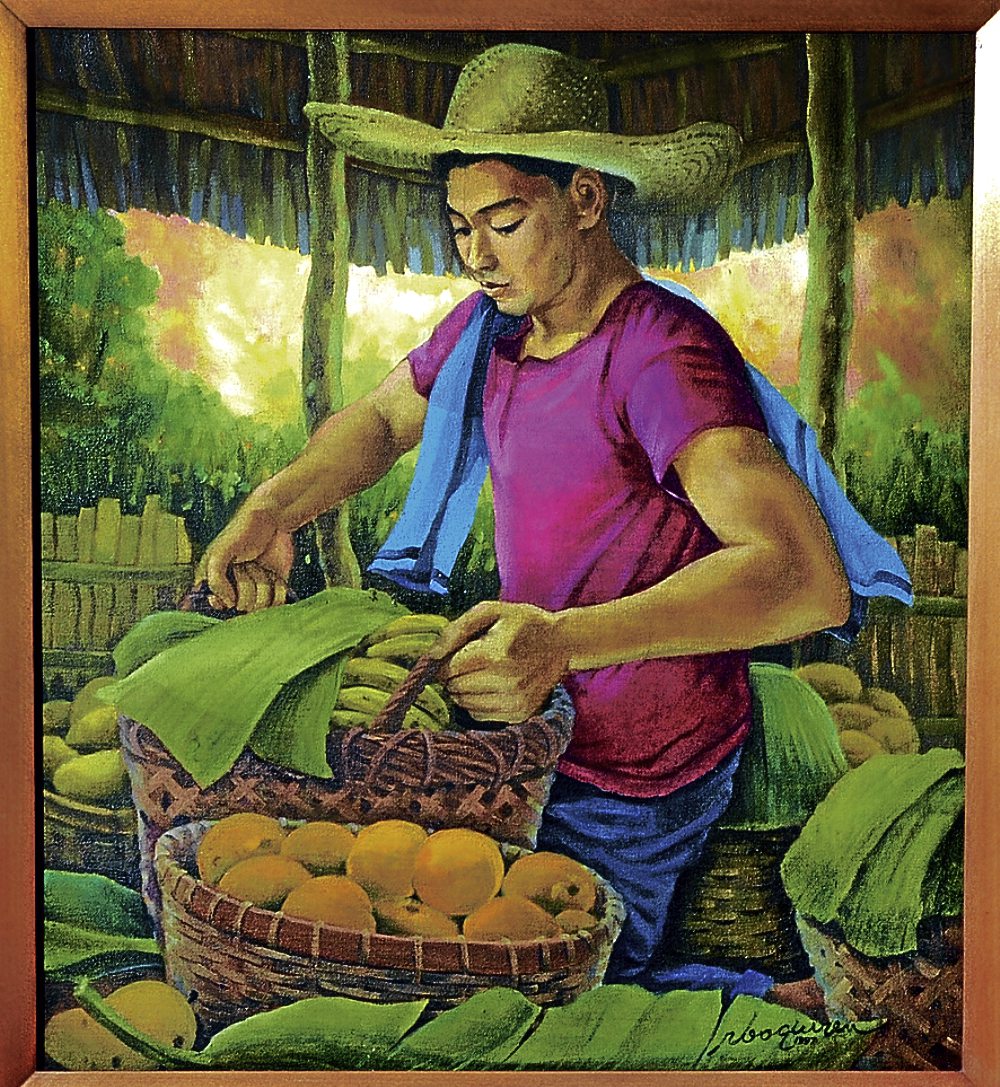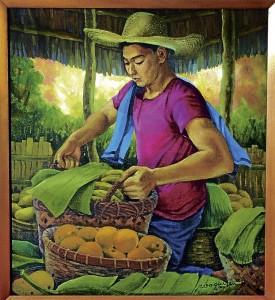
work showing amale figure
There’s an inner glow in the women of Remy Boquiren, as if a mysterious fire like that which radiates from a gemstone has been placed at the heart of the figures, highly idealized and unabashedly romantic, as only a woman of the old school could render them. Boquiren calls them “that radiant, luminous effect,” an inner light that she situates at the chest and core of the figures.
The hidden beam frames the benign, beatific demeanor of Boquiren’s women, allowing them to transcend their workaday world where they sell fruits or flowers, weave baskets, and generally labor.
Not that her women hate labor. In fact, Boquiren painstakingly shows the details of their work. Like the women-vendors of Anita Magsaysay-Ho, whom she holds in high regard, her figures are dainty but strong figures in the flux of everyday life, busy and hard at work. But their inner grace lifts them above the hurly-burly of life. They embody Hemmingway’s “grace under pressure.”
Of course, it helps that Boquiren’s women are garbed in very colorful and intricate indigenous weaves and folk attires, her famous signature. But even the costumes would look drab without the mystic glow.
The hidden-treasure quality of the folk figures will again be on exhibit in “Hiyas ng Lahi” (Treasures of Heritage), which photographer and friend Mandy Navasero is helping mount at the LRI Art Pavilion in Makati starting Jan. 24.
Retrospective
The exhibit will consist of mostly new works in acrylic and in Boquiren’s favorite medium, soft pastel. Because the space is bigger than she expected, she has asked some collectors to loan for the exhibit previous works, including one showing a woman in native attire hunched over the Bible, the only work in her ouevre that prefigured her becoming a born-again Christian.
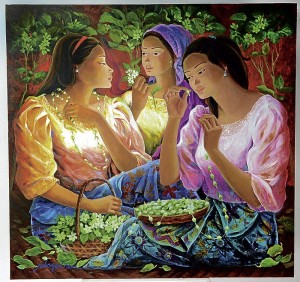
Because the exhibit consists of new and old works, it has been called a “semi-retrospective,” since, coincidentally, this year will mark Boquiren’s 39th year as a full-time artist.
Perhaps the inner light has what sustained Remedios F. Boquiren Concepcion, 74, in all these nearly 40 years of artmaking.
Even before widowhood, she had been using her maiden name as a professional painter. Possessed with the usual “housewife” skills, she has balanced home-making and art, rising early in the morning to do her daily prayers, tend to her garden and clean up the house (she lives in Marikina); then working in her studio the whole afternoon. Sometimes she would stay late at night and even up to early morning if there was a commission or an exhibition to finish.
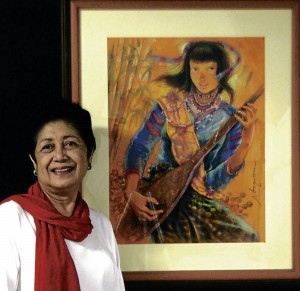
She’s not a recluse, however. She congregates with artist-friends from her University of Santo Tomas (UST) days and from the Wednesday Art Group, consisting of artists who reside east of Manila: Cris Cruz, Ben Infante, Roland Santos, Nic Masangkay, Vic Bachoco, Lisa Villasino.
The Wednesday group meets at the Pan de Americano in Marikina where members hold sketching sessions. But this summer Boquiren has requested that the group hold its meetings at SM Marikina because of the expected terrible heat. The mall management will allot a space for the artists; in turn they will give art workshops and clinics to kids at the daycare center.
In August, she will host for the group its traditional Langka Festival, an annual get-together in which Art Wednesday members feast on succulent slivers of langka that have been harvested from her garden, while sketching as they sit atop giant jackfruits.
That Boquiren enjoys her life and career should owe to her decision to hew close to art, her passion since childhood.
Growing up in Surigao City in Mindanao, she said she took to drawing and painting early on. Finishing high school, she said she was afforded only two college courses meant for women during her time—Education and Commerce. She said she was terrible in the latter and pleaded with her parents to send her to art school. They reluctantly agreed and sent her to Manila to study at UST.
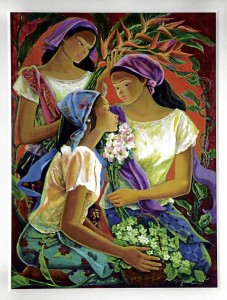
At the then College of Architecture and Fine Arts of UST, she finished BS Fine Arts in Advertising. Her mentors consisted of the first and second generations of modernists: Victorio Edades (who handled art history); Galo Ocampo (composition); Diosdado Lorenzo (drawing from life); Virgina Ty (free-hand drawing); and J. Elizalde Navarro (layout). Sculptor Napoleon Abueva taught for a semester at UST and Boquiren became a member of his class.
Boquiren’s classmates included Eduardo Castrillo, Edgar Doctor, Ivi Avellana-Cosio, Lydia Velasco-Cruz and Danny Dalena. She and Dalena were staffers at the campus publication, The Varsitarian, where she became its first woman art editor.
Boquiren remembered that their strictest mentor was the Italian-trained Lorenzo, who never gave a grade higher than 90, and who would give such ridiculously low grades as 14 and 18. Worse, he would sadistically announce the low grades in class, reducing especially the female students to tears. But he would give Boquiren and Velasco grades in the vicinity of the high ’80s.
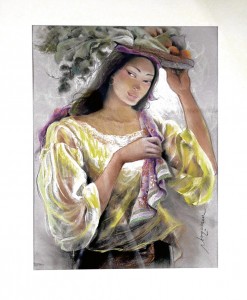
After college Boquiren worked for the old design firm of Arturo Luz. She then joined the new fine arts school of the University of the East (UE), whose inaugural dean was Pablo Victoria. Her students included Fernando Sena, Red Mansueto and Sym Mendoza.
Since she was made to handle the class in costume design, Boquiren did studies and sketches of indigenous weaves and native attires. Her researches would later serve her well when she became a full-time painter.
Although her mentorship was contributing to the flowering of Philippine art, she said teaching was gruelling, sapping her of whatever energy was left that she could devote to art. As a result, she didn’t create a single painting during her 10 years of teaching.
Resigning from UE, Boquiren returned to painting and held her first solo exhibit in 1974 in—of all places!—a rural bank in Surigao City. The results were very promising enough for her to mount another exhibit the following year—at the ABC Gallery of Larry Cruz in Harrison Plaza. Her guests included Jullie Yap-Daza, Christian Espiritu and Imelda Marcos, who snapped nine of the 23 paintings on display.
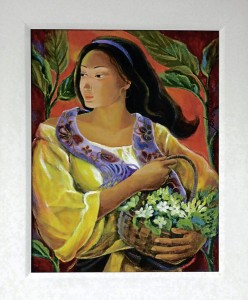
Boquiren continued her researches on native weaves and attires, studying and sketching the authentic indigenous costumes worn by mannequins in the lobby and other areas of the old Manila Metropolitan Theater.
Today, Boquiren’s women-figures are distinguished by their colorful and punctiliously detailed costumes from various Filipino tribes—T’boli, Bilaan, Subanon, Matigsalug, Ayta—as well as their hardy spirit but dainty beauty, qualities that Remy Boquiren, ever the tenacious but gracious lady, herself personifies.
Remy Boquiren’s “Hiyas ng Lahi” will run at the LRI Art Pavilion (2/F, LRI Design Plaza, Bel Air II, Nicanor Garcia Street [formerly Reposo], Makati), Jan. 24-27. From Jan. 28-Feb. 4, the works will hang at the Mandy Navasero Studio cum gallery at Suite 329, LRI Design Plaza. Call 8963208 or 0915-5430482.

